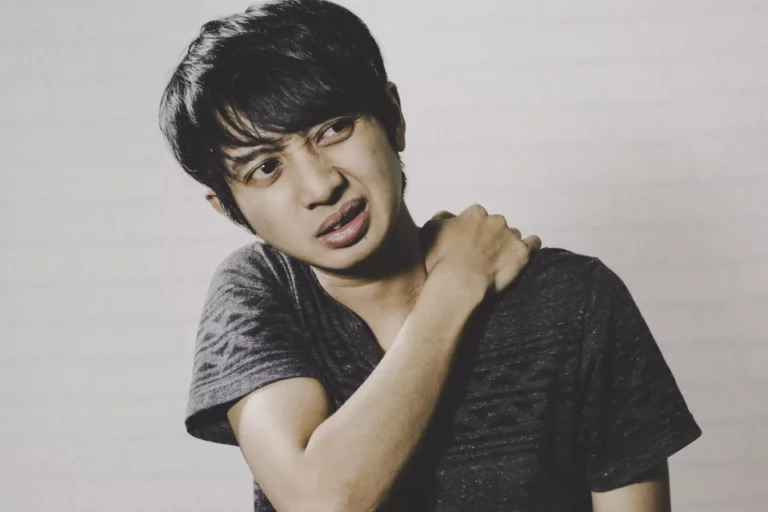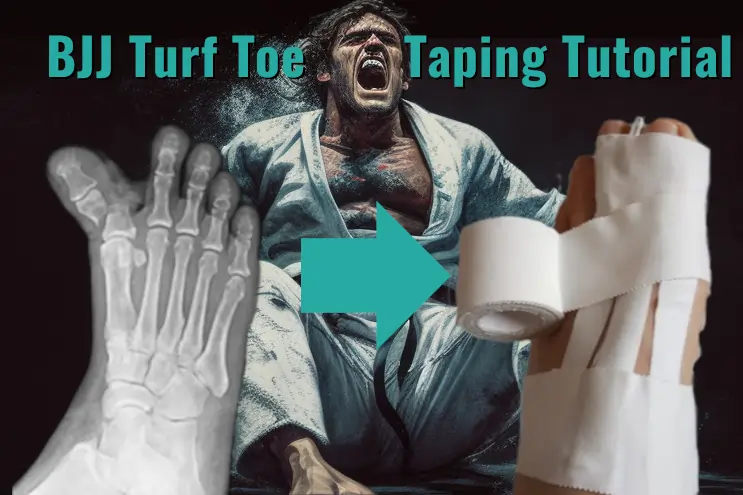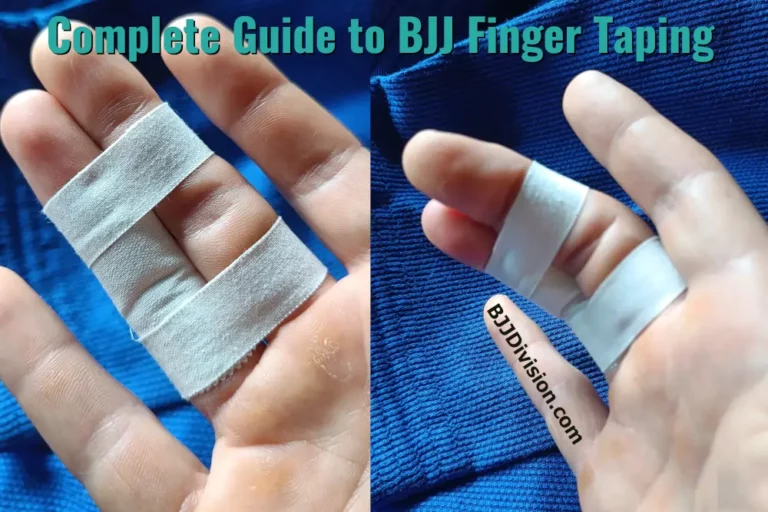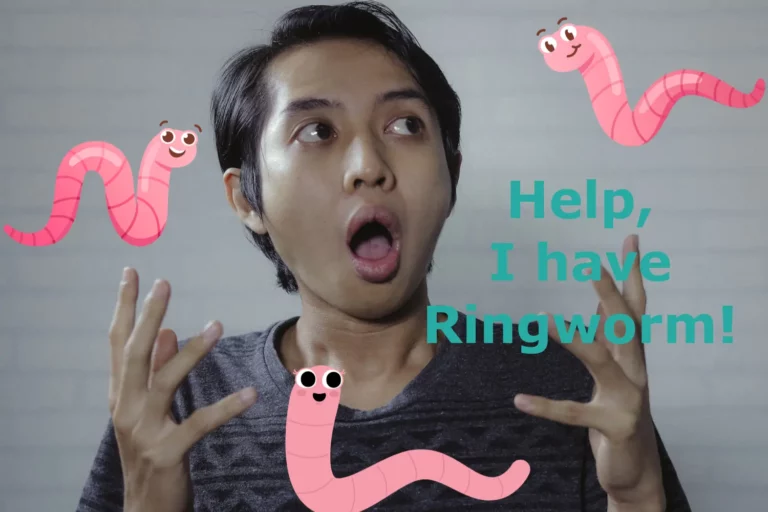Jiu Jitsu Fingers: Preventing and Treating BJJ Finger Injury
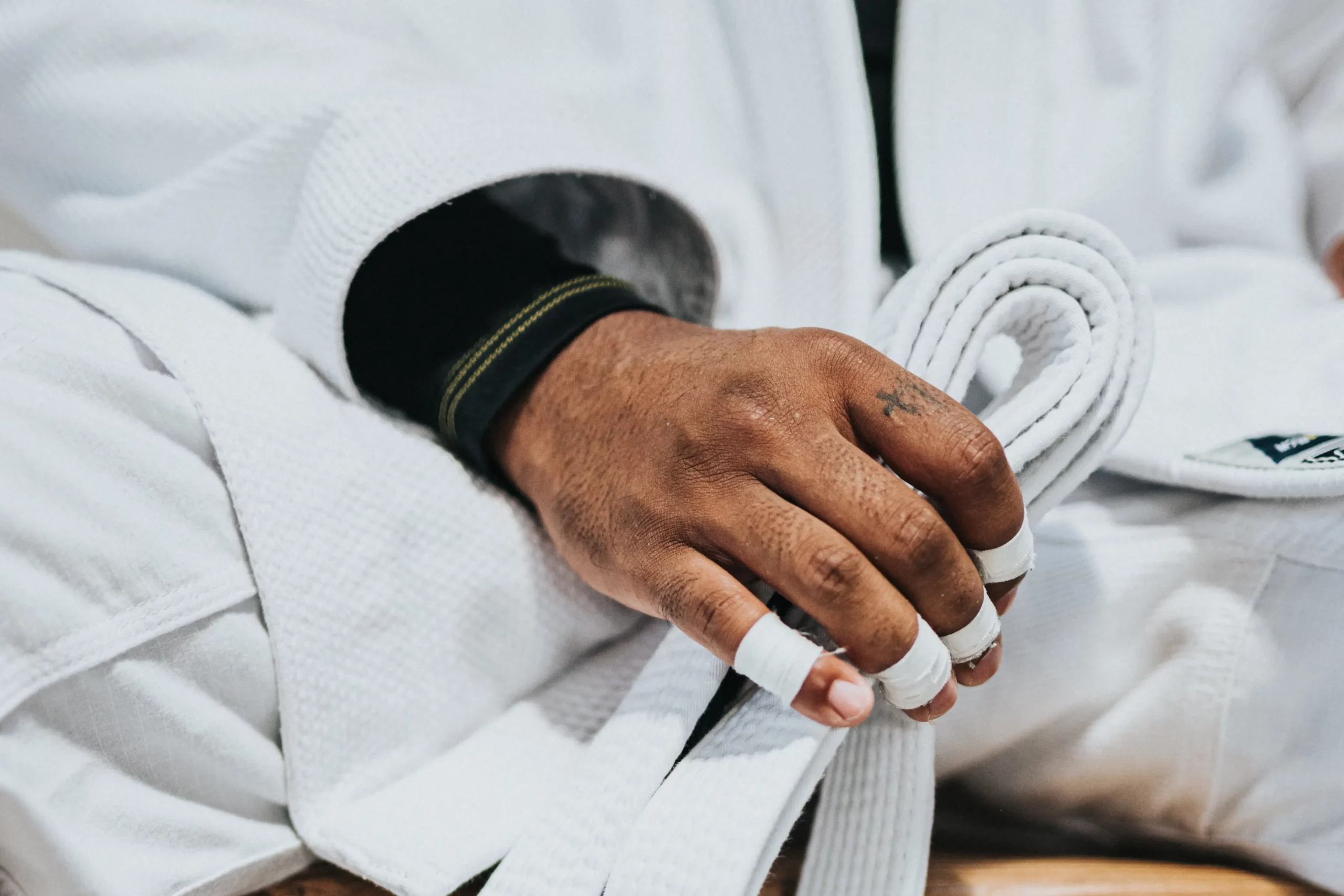
Brazilian Jiu Jitsu can put a strain on the fingers, especially when practiced in the Gi. Small joint manipulation is not allowed in Jiu Jitsu, which means the fingers can’t be targeted with submission holds or controlling grips. Nevertheless, in Jiu Jitsu fingers can always get stuck and bend in the wrong direction in the heat of the moment. On top of that, the fingers have to endure impacts and intense gripping. This frequently leads to finger injuries in Jiu Jitsu. Let’s review the most common BJJ finger injuries so we can understand and prevent them.
Keep in mind, we aim to provide you with the knowledge to understand finger injuries in BJJ and to minimize risk. Nevertheless, this guide is not a replacement for professional medical advice. When in doubt, please contact a medical professional to assess your injuries.
How common are Jiu Jitsu Finger Injuries?
We published an article on the general commonality of injuries in Jiu Jitsu a while ago. It concluded that finger injuries are among the most common injuries in BJJ as well as neck pain, on which we also wrote a separate article. The following bar chart stems from a study conducted in 2017 and shows the injury prevalence by anatomic location. The study included injuries of all severities and was derived from competition and training data.
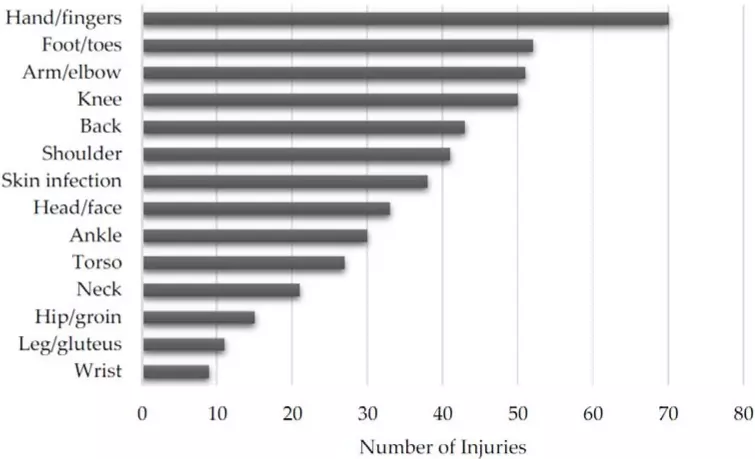
Jiu Jitsu Finger Injuries: Gi vs No Gi
All Jiu Jitsu related finger injuries that can possibly happen in No Gi Jiu Jitsu can also happen in Gi Jiu Jitsu. But not the other way around. In Gi Jiu Jitsu there are obviously additional risks to the fingers. You might get stuck with a finger in the fabric of the Gi which can lead to joints getting extended too far. Additionally, gripping itself and getting your grips ripped off from time to time puts a big strain on your fingers.
Jiu Jitsu practitioners that focus on Gi Jiu Jitsu often report severely deformed finger after years of training. This is mostly caused by repeatedly injuring the finger joints and ligaments and is called arthritis. It causes the fingers to get bigger at the joints and leads to pain, weakness and a limited range of motion. Many Jiu Jitsu practitioners experience arthritis because of prolonged wear and tear.
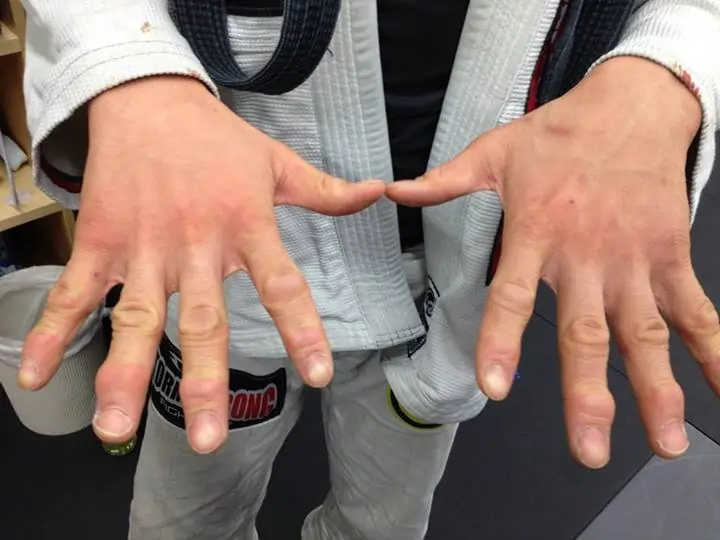
Most common Jiu Jitsu Finger Injuries: Causes and Treatments
Unfortunately, in Jiu Jitsu injuries can occur at all parts of the hand. Let’s review the most common injuries.
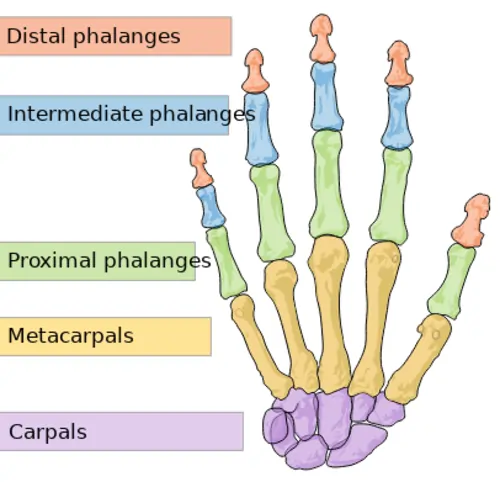
#1 Dislocation
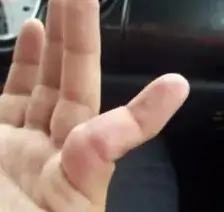
A joint is considered dislocated if the bone was pushed or pulled out of its socket. In this case the bones at the different sides of the joint don’t align anymore and the joint can’t function as the connector it was meant to be. Dislocations damage the joint as the ligaments are stretched or torn. Dislocations of the hand and finger joints most commonly affect the joints connecting the phalanges.
Causes
Dislocations are usually caused by straight or sideways forces generated through impacts against the ground or a body part of the opponent. The risk of dislocations and damage to the joints is greater if parts of the fingers get stuck or bend.
Treatment
First, the joint must be realigned. Second, the area must be cooled to reduce swelling which is especially important with joint injuries as there is usually a lot of liquid clogging up the injured area. Subsequently, the joint needs rest. As the ligaments have been stretched, the joint needs to be strengthened and carefully kept mobile through physical therapy to retain functionality and prevent subsequent dislocations. See below for our guide to supportive taping for injured fingers.
#2 Sprain & Hyperextension (Jammed Finger)
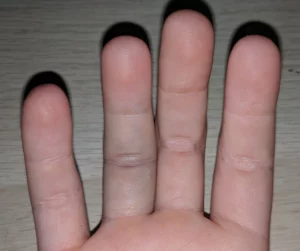
A sprained or jammed finger is the most common injury in Jiu Jitsu and combat sports in general. Unfortunately, most people had it and you will probably also fall victim to it in the future.
Sprained fingers are less severe than dislocated fingers. The injury is also caused by extending a joint too far, but not to the degree that it dislocates. As a result, ligaments are stretched and torn, compromising the strength and mobility of the joint.
Finger Sprains are usually categorized into 3 grades of severity:
- Grade 1: Small tears in the ligaments, but joint is still stable and unlikely to dislocate.
- Grade 2: Ligaments are partially torn. The joint shows signs of instability and is at higher risk of dislocation.
- Grade3: Ligaments are completely torn. The joint is instable and likely to dislocate.
Sprains most commonly affect the joints connecting the phalanges as well as the joints connecting the proximal phalanges to the metacarpals.
Causes
See causes for dislocated finger joints above.
Treatment
Treating a sprained finger is simple. Your best bet is the RICE method:
- Rest: Make sure not to damage the ligaments any further as the injured ligaments are susceptible to further damage.
- Ice: Use icing intervals of about 15 minutes to relief pain and reduce swelling. Don’t directly apply ice to the skin as you may damage the skin.
- Compression: An elastic compression bandage can reduce swelling and supports the joint. The bandage should never hinder blood circulation. Be sure not to wrap the finger too tight.
- Elevation: Swelling can be further minimized be elevating the injured area.
After sufficient recovery time, which must be evaluated individually, you should support the injured fingers through taping. This injury benefits greatly from taping and is usually easy to tape up. See below for our guide to taping sprained fingers.
#3 Fracture
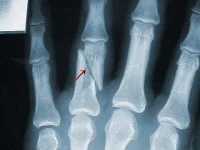
All bones of the hand and fingers can break, but the phalanges, which are colloquially referred to as “finger bones” are most likely to break. The fingers can move freely in the phalanges range. Therefore, these parts of the fingers are at higher risk of injury. The metacarpals and carpals are interconnected by muscles and tendons making this part of the hand more durable.
Causes
The main causes of finger fractures in Jiu Jitsu are impacts, e.g., if someone lands on his opponent’s hand or fingers. Fingers can also get stuck and as a result torqued until they fracture.
Treatment
Possible fractures should be examined by a medical professional through x-ray images. Your doctor will then decide if the bones must be realigned and how to treat the injury. For a few weeks the broken finger will have to be completely immobilized which is usually done by wearing a finger splint/brace. After the initial healing period it might be sufficient to support the finger by taping. More on taping later in this article.
#4 Post-Traumatic Arthritis
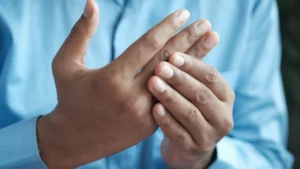
This form of arthritis is common after traumatic injuries in BJJ. It results in stiffness, pain and a limited range of motion. It is inflammation in the joint that causes the afflictions.
Causes
Contrary to other forms of arthritis, post-traumatic arthritis develops quickly after an injury occurred instead of being a result of prolonged wear and tear. Typical causes are overextension of the joint and rapid movement within the joint. Both are usually results of uncontrolled impacts. Therefore, post-traumatic arthritis often succeeds prior significant injuries like dislocations and fractures like described above.
Treatment
Surgery is rarely needed to cure post-traumatic arthritis. X-Ray, MRI and CT scans can help with identifying injured bones or tissue.
In most cases, proper rest is the only is the only thing that can cure post-traumatic arthritis and it might take a few months. After the initial resting period, the recovery process should be supported through physical therapy in order strengthen the injured area and restore range of motion. Wearing a brace or supporting the injured joint through tape is always a good option.
Preventing Jiu Jitsu Finger Injuries

Unfortunately, finger injuries in Jiu Jitsu are unavoidable. Sooner or later, you will experience pain in you’re a finger joint, either from an acute traumatic injury or as a result of the wear and tear Jiu Jitsu causes.
Nevertheless, there are some general things you can do to make injuries less likely to happen and less severe:
Taping
We get it, you might not want to tape up your fingers just in case. We recommend at least taping up the fingers that have been subject to injury in the past or fingers you feel are likely to experience strains.
Just try it out. In our experience it is always worth it to spend a little additional money on tape than getting injured regularly or even chronically. For a detailed explanation on how to tape your fingers, see below.
Moving Cautiously
Do you remember the first few training sessions after your last injury? You always had the previous injury in the back of your head and moved considered to avoid further injury to the body part. Whatever part of our body is injured, as long as it still hurts, we realize how often we actually put stress on the injured body part. As we heal up, we often get careless again. When training Jiu Jitsu, injured or not, try to preserve some of that cautiousness to preserve joint health. Don’t get overconfident, don’t get cocky.
Strengthening
Your fingers will get stronger over time just through training Jiu Jitsu, but you will also catch injuries that effectively weaken your joints. But there are ways to strengthen the finger without risking setbacks.
Let’s consider rock climbing, the sport that needs the most finger strength out of all sports. A rock climbers’ main tools are his fingers. They must be strong and healthy. A simple way to strengthen the fingers effectively is to copy what rock climbers are doing which is climbing, hanging from small holds (hangboarding) or climbing steep walls with small holds. Obviously, you don’t have to become a professional rock climber to have strong fingers and you should take it easy at first.
We encourage you to look up some rock-climbing finger strengthening routines. They will make your fingers stronger and more robust.
Warming Up
You should generally try to warm up most joints and muscles of your body before engaging in a Jiu Jitsu class or fight since Jiu Jitsu uses every single part of the body. To what extend warming up can prevent finger injuries in Jiu Jitsu is not completely resolved yet. At the very least it will make your fingers feel mobile and ready to grip.
Jiu Jitsu Finger Taping
The positive aspect about finger injuries to the frontal finger joints is that you will be able to train anyway if you tape your fingers up correctly.
This article focuses on the most important taping methods which are especially helpful for previously sprained or dislocated fingers. We wrote an in-depth article that covers more sophisticated taping methods on Taping for Jiu Jitsu in general. Feel free to check it out if you need further instructions. The following two methods will support most sprained finger injuries that happen through Jiu Jitsu.
Sidewards Support – Buddy Taping
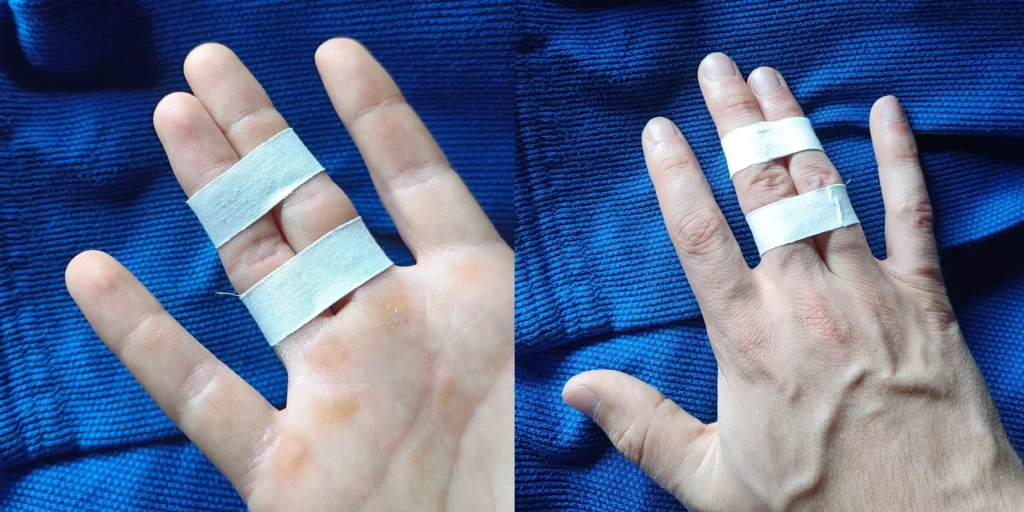
Simply tape the injured finger to an adjacent finger on both sides of the injured joint. This kind of taping will limit sideways movement of the fingers and preserve bending ability. It can be a life saver. You can either use narrow stripes of tape or a finger connector specifically designed to support this kind of injury. If you use tape, make sure to use long stripes you can wrap them around the fingers more than once. It’s essential since tape sticks much better to tape than to skin.
Bending Support

Simply use a wide stripe of tape to wrap the injured joint. It should be wrapped tight to provide stability to the joint but should never cut off blood circulation. As a result, the finger can’t be bend completely.
Full Support
We have used both kinds of taping from above numerous times throughout the years and benefitted greatly from it. Combining both methods will provide the greatest amount of support in all directions:
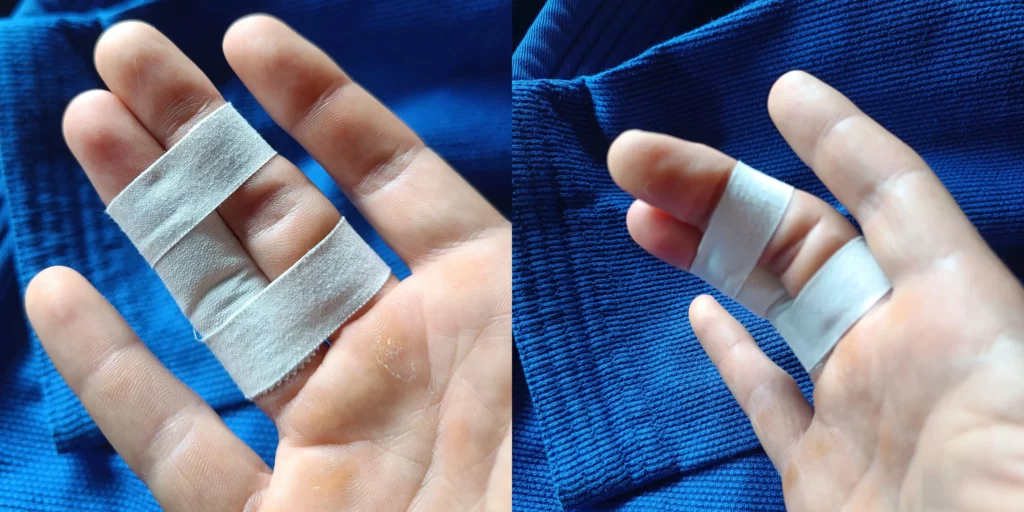
Conclusion
Injuries in Jiu Jitsu can be annoying and painful, especially reoccurring injuries. Therefore, it is important to let your injuries heal up sufficiently. It is not easy since it’s hard to take time off the mats when you’re dedicated, we have all been there. Just keep in mind that you are probably planning to do Jiu Jitsu for many years to come. What are a few days or weeks of recovery compared to many years of fun on the mats? Be careful so you can enjoy rolling and progressing for many years to come.



